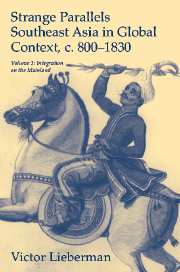Book contents
- Frontmatter
- Contents
- List of Figures
- Principal Political Eras on the Mainland
- Abbreviations Used in the Notes
- Preface
- 1 Introduction: The Ends of the Earth
- 2 One Basin, Two Poles: The Western Mainland and the Formation of Burma
- 3 A Stable, Maritime Consolidation: The Central Mainland
- 4 “The Least Coherent Territory in the World”: Vietnam and the Eastern Mainland
- Conclusion and Prologue
- Index
3 - A Stable, Maritime Consolidation: The Central Mainland
Published online by Cambridge University Press: 06 January 2010
- Frontmatter
- Contents
- List of Figures
- Principal Political Eras on the Mainland
- Abbreviations Used in the Notes
- Preface
- 1 Introduction: The Ends of the Earth
- 2 One Basin, Two Poles: The Western Mainland and the Formation of Burma
- 3 A Stable, Maritime Consolidation: The Central Mainland
- 4 “The Least Coherent Territory in the World”: Vietnam and the Eastern Mainland
- Conclusion and Prologue
- Index
Summary
The histories of western and central mainland Southeast Asia were closely joined and reasonably comparable. The central mainland is here defined as present-day Thailand, Laos, Cambodia, and more peripherally, the Mekong delta. Although in fact communications between this region and China were at least as easy as with South Asia, from an early date India and Sri Lanka provided the central, no less than the western, mainland with its chief high cultural inspiration. The broad similarities between the western and central mainland in art, literature, law, kingship, and Theravada affiliation that grew from this common South Asian exposure were reinforced by a constant west-central exchange. Monks, diplomats, traders, soldiers, and migrants showed that upland barriers between the Irrawaddy, Chaophraya, and Mekong river systems were relatively porous. Thus a unique Theravada civilization embracing virtually all wet-rice areas in the western and central mainland cohered and diverged from the ever more Sinic eastern sector.
To these shared cultural traditions must be added the unifying effects of demography and geography, particularly in what became the two chief Theravada kingdoms, Burma and Siam. In both kingdoms a semicircle of highlands surrounded a great alluvial plain whose chief river, the Irrawaddy or Chaophraya, provided the main avenue of communication. In both sectors a maritime coastal region competed with a less commercially privileged interior zone.
- Type
- Chapter
- Information
- Strange ParallelsSoutheast Asia in Global Context, c.800–1830, pp. 212 - 337Publisher: Cambridge University PressPrint publication year: 2003



